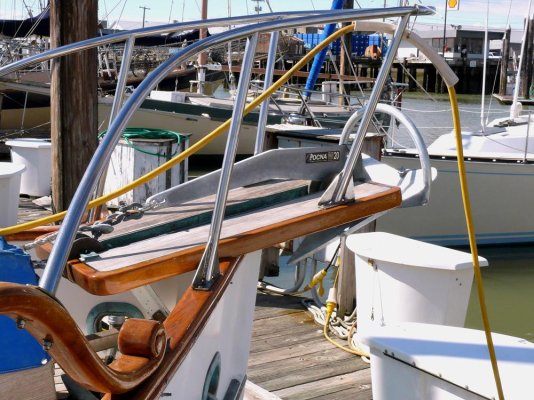The Bruce anchor is not a plow anchor, it's a claw anchor. The Rocna is not a plow anchor,*either,*it's a spade anchor.* Think about it for a moment--- a plow shape is designed to dig into the dirt, but also move forward through the dirt*as you pull on it.* A spade shape is designed to dig into the dirt but then resist forward movement.
We had some unsettling dragging experiences with our Bruce, which we bought originally because of its repuation for fast setting. We knew at the time the Bruce was rated one of the lowest in terms of holding power but we didn't think that would be an issue in our relatively protected waters.
Anyway, after our not-so-great experience with the Bruce I started looking around to see what alternatives might be better. A comment on the Grand Banks owners forum led me to research the Rocna, and after viewing the video on their website (which illustrates some rather disturbing traits of "old generation" anchors like CQR, Bruce, Danforth, etc.) and reading all the tests and testimonials I could find, we ordered one. Fortunately, those of us in the PNW don't have to pay shipping from New Zealand--- Rocnas are made under license by Suncoast Marine in Vancouver, BC. So we simply drove up one Saturday and picked it up.
We have not had a lot of experience with this anchor yet as we haven't had it all that long. So I can't attest to its performance in strong winds/strong waves--- you'll have to let the testimonials on the website do that.
But I can attest to the speed and power of its setting. Every time we've use it, it sets so fast and hard it actually yaws the boat around when the all-chain rode tightens up.
So it sets faster than the Bruce (and apparently most other anchor types as well), and in tests it's holding power is at or near the top of the list, as opposed to the Bruce which is always at or near the bottom of the list. The purpose of the roll bar on the Roca is to ensure that no matter how it lands on the bottom it will always roll over onto its side which is the optimum position for digging in and setting.
The Rocna is one of the so-called "new generation" anchors, but it does not incorporate brand new features so much as it combines features--- like the roll bar and the sharp, concave spade shape--- that have proven successful on other types of anchors. I believe one of the Rocna-unique features is the so-called "skid plate" between each end of the roll bar and the sides of the spade that help the anchor pivot down and dig into the surface.
So far, based on our limited experience and everything I have read from people who have them, the only downside to the Rocna is it's price---- they are not inexpensive, even if you don't have to pay shipping.
Some boats with what I call "Bayliner pulpits"--- pulpits that extend forward of the anchor's postion and that have a slot for the anchor shank to come up through--- may have trouble mounting a Rocna because of the rollbar. But as you can see, the Rocna fits fine on the more traditional-style pulpit like the one we have on our older Grand Banks.
But I would strongly advise anyone interested in a new-generation anchor like the Rocna to watch the video on the Rocna website
http://www.rocna.com* Even if you aren't interested in a Rocna per se, the shots of how more traditional anchors can perform (or not perform in this case) is pretty educational.
-- Edited by Marin at 11:53, 2007-10-29
-- Edited by Marin at 11:58, 2007-10-29
-- Edited by Marin at 11:59, 2007-10-29
-- Edited by Marin at 12:01, 2007-10-29
-- Edited by Marin at 12:04, 2007-10-29
